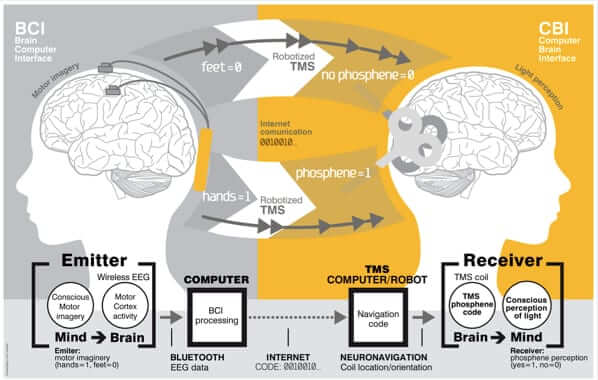
Scientists in India and France have successfully transmitted a brain-to-brain thought, or communication, over the Internet. Using a non-invasive procedure, scientists in India wired a man’s head to capture and decode his brain impulses, had the man think the words “Hola” and “Ciao”, and then transmitted the impulses over the Internet to recipients that colleagues in France had wired similarly, who received the transmission as flashes of light, from which they were able to interpret the “Hola” and “Ciao”. The scientists involved were Carles Grau, Romuald Ginhoux, Alejandro Riera, Thanh Lam Nguyen, Hubert Chauvat, Michel Berg, Julià L. Amengual, Alvaro Pascual-Leone, and Giulio Ruffini.
Last year was the first time that scientists proved that the digital impulse from one person’s brain could be transmitted to and received by another person. In that experiment, the sender caused the recipient’s finger to move.
Said Andrea Stocco, a researcher at the University of Washington, who was involved with the finger-moving experiment, “The Internet was a way to connect computers, and now it can be a way to connect brains. We want to take the knowledge of a brain and transmit it directly from brain to brain.”
And that – transmitting directly from brain to brain – is essentially what was reported this week.
In an abstract published in the Public Library of Science (PLoS), Grau, Ginhoux, Riera, Nguyen, Chauvat, Berg, Amengual, Pascual-Leone, and Ruffini explain:
The Internet Patrol is completely free, and reader-supported. Your tips via CashApp, Venmo, or Paypal are appreciated! Receipts will come from ISIPP.
“Human sensory and motor systems provide the natural means for the exchange of information between individuals, and, hence, the basis for human civilization. The recent development of brain-computer interfaces (BCI) has provided an important element for the creation of brain-to-brain communication systems, and precise brain stimulation techniques are now available for the realization of non-invasive computer-brain interfaces (CBI). These technologies, BCI and CBI, can be combined to realize the vision of non-invasive, computer-mediated brain-to-brain (B2B) communication between subjects (hyperinteraction). Here we demonstrate the conscious transmission of information between human brains through the intact scalp and without intervention of motor or peripheral sensory systems.”
How Brain to Brain Communication Works
Pascual-Leone, in an article in Live Science, explains that they wanted to determine “Could we develop an experiment that would bypass the talking or typing part of the Internet and establish direct brain-to-brain communication between subjects located far away from each other, in India and France?”
Having now done so, says Pascual-Leone, “We believe these experiments represent an important first step in exploring the feasibility of complementing or bypassing traditional language-based or motor-based communication.”
This has enormous implications for those who are no longer able to speak coherently due to injury or illness.
It also has, potentially, enormous implications in the future for covert operations. Between this, and being able to eavesdrop by reading vibrations in objects near the speaker, the NSA should be busy for some time to come.
The Internet Patrol is completely free, and reader-supported. Your tips via CashApp, Venmo, or Paypal are appreciated! Receipts will come from ISIPP.









